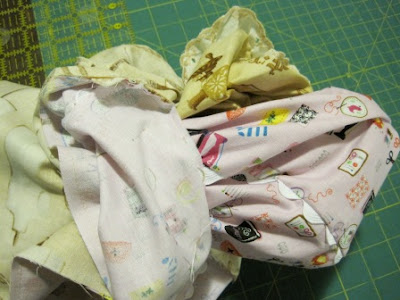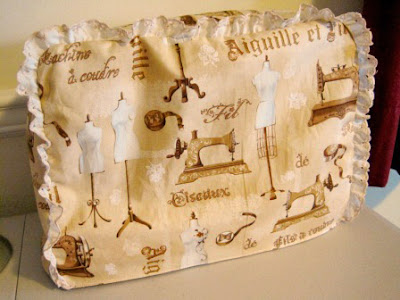It's not a good idea to leave your sewing machine undressed for too long. Sure, we all do it sometimes--when we're in the midst of a project or getting back to it the next day. But leaving your machine uncovered for long periods of time can lead to dust-borne illnesses :) You don't want dust getting in between your tension disks, or somehow squirming its way into your machinery. We want to keep our machines as gunk-free as possible, and one of the easiest ways to do this (other than giving it a good brush-out now and then) is to keep it covered when it's not being used. I've seen several covers that work as a blanket, essentially--you lay it over the top and tie it on the sides. This makes it much cuter than when it's nekkid, but it still leaves the sides open and exposed. So today I'm going to show you how I made the cover for my machine that covers it from all sides. The one on there was old and I had actually made it for my Singer, so I decided to get rid of the hand-me-down and make something new.
Last week during my fabric buying trip, I found two adorable fabrics that I couldn't decide between for this, so I made a reversible cover that I can flip-flop to suit my mood. I had a yard of each with a good bit left over. The first one is the one that I ended up tea-staining my trim for:
See? Regular white trim just wouldn't do with this fabric...
And I love this one for the pure noveltyishness of it (that's a new word I just created--look for it in the Oxford English Dictionary next year):
I am using a large white rick-rack for this side--trims make things more fun. True story.
First you'll need a few measurements. You're going to want to measure the machine at it's widest spot--don't forget to include the handwheel:
After I did this I measured the hand wheel for a total of 16 1/4 inches.
This is Lola, by the way. She's my BFF.
Then you need to measure from the table to the highest point (mine is the bobbin holder...thingeee):
Ignore my giant sweatshirt sleeve--I swear my forearm is not that large.
This ended up being 12 1/4 inches high.
Those are the measurements for my front and back pieces. I used quarter inch seam allowances, so I cut two pieces 16 3/4 inches wide by 12 3/4 inches high. I used a cup to gently round the top edges:
Doing this makes sewing in the gusset much easier than if the edges were square. That can be done too, but I'm all about easy and I like the gentle curve this gives.
The next measurement is from the table on one side, around the top, to the table in the other side. Try to include the high and wide points here (which I did but doesn't show in the picture):
I ended up with 37 inches from this measurement.
The last measurement needed is the depth of the machine (at the widest spot):
Seven inches exactly.
So for the gusset I cut a piece 37 1/2 inches by 7 1/2 inches. You may have realized something here--I didn't account for ease. I didn't realize this until halfway through, but it ended up fitting perfectly. Doing this again I would add a half inch to my measurements for ease. You can do that now, or you can go with my snugger way of measuring that I did. Also, some people like to make their gusset extra long and trim off any extra later. If you're newish to gussets I would definitely do that if your fabric allows.
So at this point you should have 2 rectangles for the front and back, and 1 loooong rectangle for the gusset, out of each fabric. If you're using a trim, I would baste it down to the front/back pieces--makes life easier.
See how the curved corner makes that trim go on easy peasy?
Next, take your gusset and pin it all the way around. Again you'll see how that curved corner makes it a bit easier and neater. I use a lot of pins in the corners just to keep everything neat:
Start sewing. I like to have the gusset on top--there's a bit of extra fabric at the corner and it's easier to manipulate if you can actually see it. Take your time when you get to the corners. Stop and adjust your fabric if you need to.
Sorry for the terrible photo but it shows the necessary part well enough. To the left of the presser foot all that extra fabric is the gusset. If you keep it straight and out of the way you should have no problem with unintentional pleats as we're using a small seam allowance.
When you've finished, check that you don't have anything wonky. If you do, unpick and restitch. Then, do the other piece. At this point you should have an idea of what this will look like:
If your gusset is too long trim those extra bits now.
Then do it again. It goes much easier the second time. You should now have a second piece that looks like the first:
My rick-rack skills could use some work, but that's another day...
Now put one inside the other, right sides facing, and pin all around the bottom. Match up your seams as you go. Since we're going to turn it right side out here, leave a gap of a few inches.
We're almost done. Promise.
Sew using a quarter inch seam allowance all the way around. Don't forget to leave the turning gap open! Now, stick your hand in through that hole and gently coax the whole thing out through it, trying not to rip any stitches.
Some call this birthing. I think you can figure out why :)
Now it looks like this:
Kind of like non-identical conjoined twins...which would be interesting if it wasn't impossible. Except when you're sewing :)
Now push one inside the other. Some people might press the edges here. And then there's me. Lazy. So I traveled around the bottom edge, pinning everything nice and neat, including the gap we left.
I do apologize for the awful photos. The lighting in my dining room is iffy sometimes.
Top-stitch an eighth of an inch from the edge. And that's that. Slap that baby on your machine and consider her dressed!
Two looks--one easy project!
Here are a few extra tips:
~ If you want something much more structured you can interface your fabric or even use some fleece. I used neither for this. I used the same process for a toaster cover and used fleece--it does look quite nice.
~ This could be wicked adorable with patchwork.
~ Slap a few handles on and turn it the other way and you've also got a bag.
~ If you don't want to make it reversible use something plain for the lining and don't include trim on that side.
As ever, if you have any questions please let me know. Ta!
I'm link-a-dink-a-doo-ing here this week:






















I have a serious case of FABRIC-COVETING right here, you have no idea.
ReplyDeleteAnd this turned out so pretty! Clever, too :)
this is so cute....i have yet gotten my machine out of its box and i know when i do it has to be covered.....i so am hoping in the next month to get a spot set up in spare b-room which is almost painted...just have floors to do yet....i will save this to favorites!
ReplyDeleteNICE!!
ReplyDeleteThis is lovely! Love the fabrics, love the trim. Unfortunately I'm right in the middle of making a sewing machine cover at the minute... not sure if I can justify having 2!
ReplyDeleteI'm guilty of always leaving my machine uncovered. I used to use the cover it comes with but it looks so plastic and shiny. I have a Janome too!
ReplyDeleteLove it! So cute! I'd love to have you link this up at my new Link Party!
ReplyDeletehttp://sarahndipities.blogspot.com/2011/03/make-something-monday-link-party-1.html
-Sarah
I like it, it's like a great outfit for you machine. Must find myself fun fabric for mine too, it's sitting naked on the table right no.....
ReplyDeletePerfect! Just what I need...
ReplyDeleteToo cute! I love both, but something about the first look is my favorite!
ReplyDeletexo,
Sena
I love this! Adorable! I would love for you to link up to my Ten Buck Tuesday link parties!
ReplyDeleteYou did a great job on the cover! Two looks for one project! Great idea!
ReplyDeletecarla louise
www.ohsewaddicted.com
Thanks so much for linking up the Make Something Mondays! Can't wait to see what you have next week!
ReplyDeleteWow! This is so cool. My sewing machine is old and folds down into the table but it has an old dusty plastic cover that (I now think) needs to be replaced!
ReplyDeleteThanks for sharing this, I am planning on making one for my daughter, and now I have a tute to follow! Thanks also for linking up to Fantastic Friday. I hope that you will join us again next week!
ReplyDeleteI so love your fabrics! And I love your sewing machine cover! I am featuring this on saturday! thanks for linking up! I look forward to seeing you this week again!
ReplyDeletePlease ship that sewing machine to me in Richmond via Fed Ex. Haha, I want it!!! BTW I'm going to use your tutorial to make a toaster cover, same idea right? Do you think I should line it with ... Thinsulate or whatever it's called, or just quilt padding, or just nothing? Lemme know, my toaster is shivering.
ReplyDeleteThank you so much for this!!! I am so excited for my sewing machine to be dressed, poor thing has been nekkid for way too long! :)
ReplyDeleteI really LOVE this compared to my other pattern. THANK YOU!
ReplyDelete